Making Afro Latin Jazz Dance ‘Shine’ With a Reunion of Styles
BY BONNIE EISSNER
Note: This article was first published in Stance on Dance’s spring/summer 2024 print issue. To learn more, visit stanceondance.com/print-publication.
On a Sunday night last November, about 250 people, many of them dance enthusiasts and experienced social dancers, packed the rotunda of the Guggenheim Museum in New York City to learn salsa moves from choreographer, dancer, teacher, and musician Sekou McMiller.
Accompanied by the reverberating rhythms pumped out by DJ John John, the lesson and subsequent dance party topped off a works-in-process presentation of McMiller’s latest choreography. Titled Shine, the jubilant performance featured a mash-up of choreographed partnered Latin jazz dances, such as mambo, salsa, and cha-cha-cha, and moments of individual, improvised dancing, called shines.
The breakouts gave McMiller and the six other dancers who joined him moments to react to the jazz and soul rhythms that emanated from Sebastian Natal, who played percussion, piano, and bass.
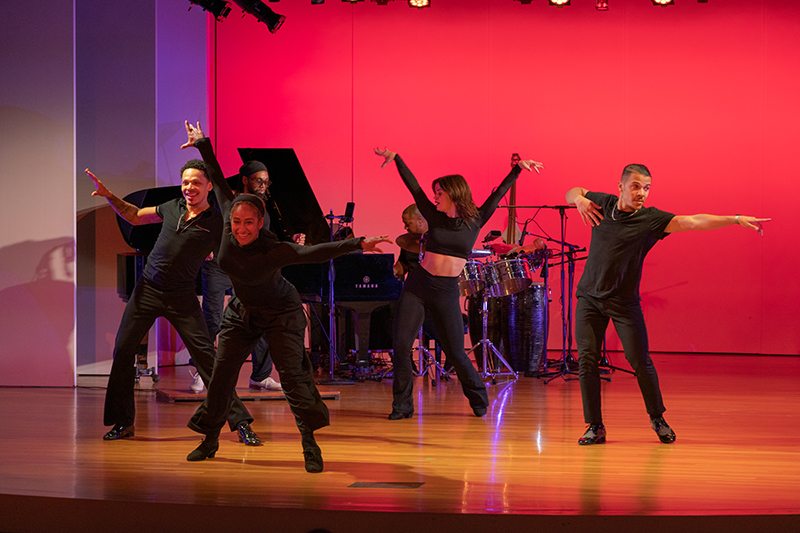
Shine by Sekou McMiller at Works & Process at the Guggenheim on November 5, 2023. Presented in partnership with Jacob’s Pillow. Photo: Works & Process / Erick Munari
“I’ve always said, ‘Live your life,’ if you’ve ever taken a class with me,” McMiller said in an onstage discussion between the dance numbers. The dancers did just that as they performed.
Later, when he demonstrated the salsa moves in the rotunda, McMiller, tall and broad shouldered, reminded the buoyant crowd to do the same. “Live your life,” he called out at intervals during the social dance.
The short phrase encapsulates McMiller’s approach to dance and to his own life. A former corporate accountant and classical flutist, he is an admired dancer and an influential dance teacher. He is also gaining attention for high-energy choreography that fuses Afro Latin jazz dances with contemporary urban styles, like hip-hop.
McMiller is an adjunct professor at NYU Tisch School of the Arts, The Ailey School, the Joffrey Ballet School, and Marymount Manhattan College. His Ailey School jazz dance class was featured in the documentary Uprooted: The Journey of Jazz Dance, which is now streaming on Max. And he was recently appointed the curator of special projects at the National Jazz Museum in Harlem.
He has performed and choreographed for a range of artists, such as salsa singer Gilberto Santa Rosa, rapper Pitbull, and Madonna. Through his own dance company, he explores the African and Caribbean influences of Afro Latin jazz dance, urban dance, and modern jazz. In 2017, he received a fellowship from the Alvin Ailey Foundation’s New Directions Choreography Lab and a residency from the CUNY Dance Initiative to create I Am Pulse, the second installment in what he calls his “Afro Latin Jazz and Soul Experience” series.
Shine is the latest in that series. McMiller created it during a 10-day residency at Jacob’s Pillow, the famed dance center in the Berkshire Mountains of Massachusetts. The residency culminated in the Guggenheim performance.
Melanie George, an associate curator of artist initiatives at Jacob’s Pillow, proposed McMiller for the selective Pillow Lab residency. “I think a lot of people know Sekou as a great teacher,” George said, “and I know him as a great artist and an incredible mover, just effortlessly rooted and graceful and inventive. It’s a language that he speaks fluently. That’s the kind of artist that I would always want to support.”
During an onstage interview with McMiller at the Guggenheim performance, George prompted him to talk about his versatility in dance and music styles. “How is it that you landed on what you do?” she asked. “I have these languages in my body from these dances, this vernacular in my body,” he said.
McMiller, who is 49, grew up on the West Side of Chicago, the second youngest of seven siblings. “I’m the same age as hip-hop,” he said during an interview a few weeks later. “As a young person, I was a hip-hop dancer carrying a cardboard box with me.” An older brother had a boom box, and they both danced and battled with the kids on the next block. They followed early rappers like LL Cool J and KRS-One. “Hip-hop was this extremely positive experience in my youth,” McMiller said, observing that the push for profit changed the music and the messages.
When house music swept Chicago in the mid-1980s, McMiller became a house dancer. “Dance was always there in my life,” he said.
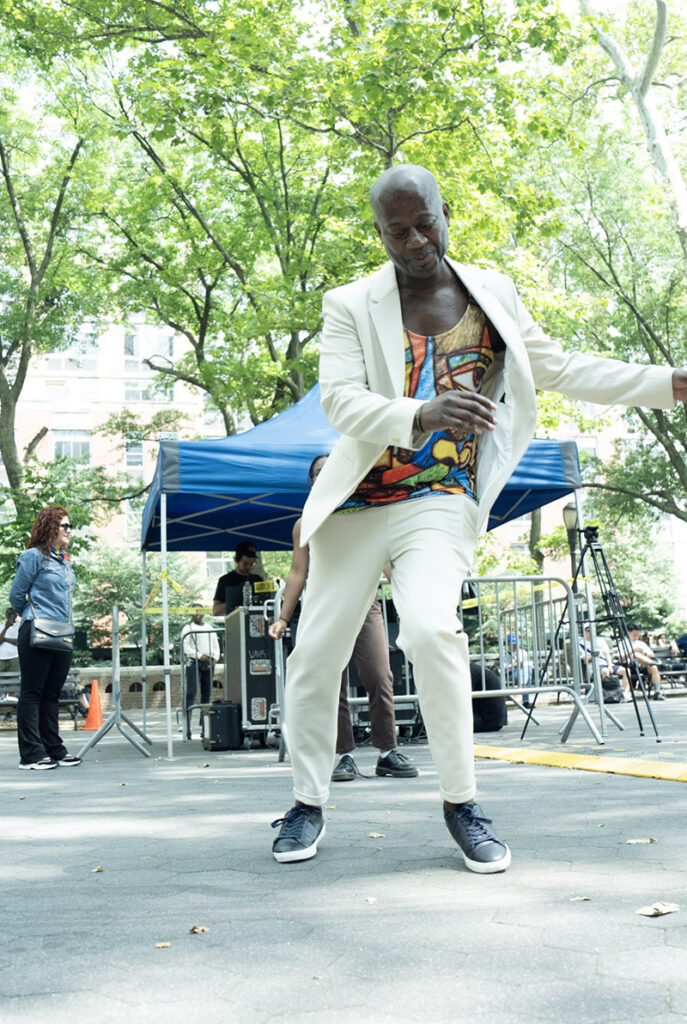
Sekou McMiller at the National Jazz Museum in Harlem’s Juneteenth Black Music Month celebration at Jackie Robinson Park in 2023. Photo by Sekou Luke.
Dance was a part of family life too. At gatherings and parties with his mother’s friends and his aunts and uncles, he and his six siblings would dance, put on plays, and perform music. A brother played the organ. His sister played the flute.
When he was around 11 or 12, McMiller would slip into his sister’s room to teach himself the flute. As a high school freshman, he bragged to his music teacher that he could play the flute and was assigned the instrument, even though he wanted to try saxophone. But he took up the challenge. He stayed after school to practice and became good enough to qualify for the Merit School of Music in Chicago, which led to him also joining the Sherwood Conservatory of Music and then and the elite Chicago Teen Ensemble, a group of six young musicians who included Anthony McGill, now principal clarinet of the New York Philharmonic, and Demarre McGill, now principal flute of the Seattle Symphony.
It was at the University of Illinois Urbana-Champaign, where McMiller studied accounting and musical performance, that he encountered Latin American culture for the first time. “That’s when I got exposed to salsa music and going out dancing, and I fell in love with it,” he said.
McMiller returned to Chicago to work as an accountant. In the evenings, he played flute with orchestras and chamber groups. “That was a heck of a situation, being in corporate America in the 90s with dreadlocks; it was not easy at all,” McMiller said. He would go salsa dancing as a form of therapy.
He rose to become the chief financial officer of a company based in Chicago and Cincinnati, and over time, dance became a steady sideline. Informal gatherings in his apartment where he showed friends his salsa dance moves snowballed into paid teaching gigs. Eventually, he was flying out most weekends to places across the country and around the world — Europe, Africa, Asia — to teach and perform salsa and Latin dance.
When his employer announced that it was moving to New York, McMiller took the opportunity to make dance his full-time job. He didn’t want to live in New York, he said. He also knew that “dance was inspiring me more.”
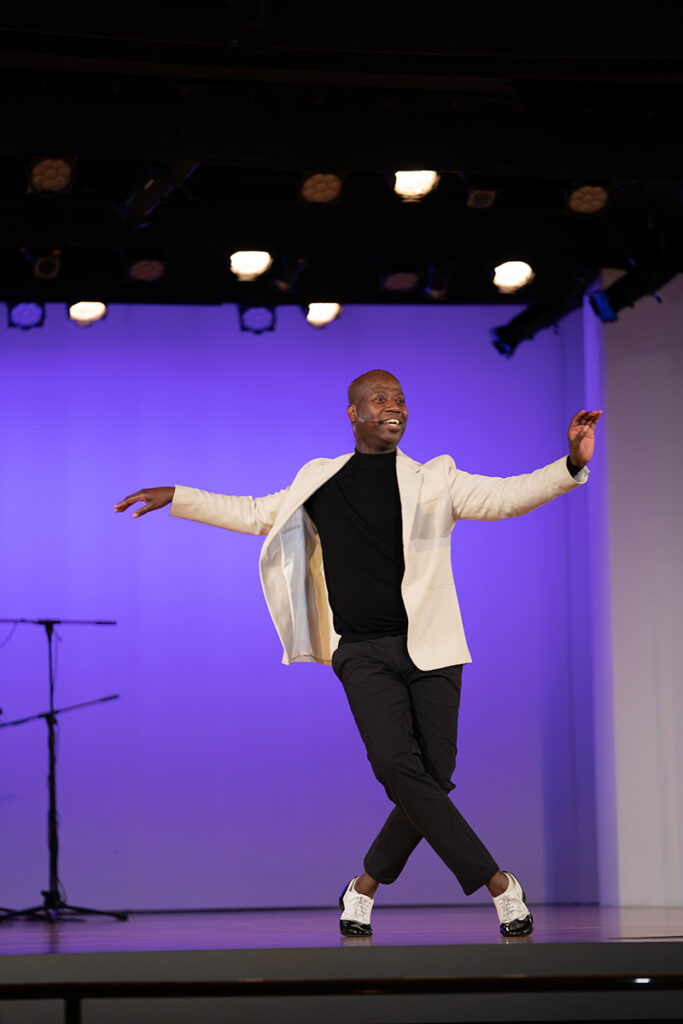
Sekou McMiller performs in Shine at Works & Process at the Guggenheim on November 5, 2023. Presented in partnership with Jacob’s Pillow. Photo: Works & Process / Erick Munari
He went broke before he acknowledged he had to change his spending habits and become his own accountant. He righted his balance sheet, and in 2007 he was invited to New York to help re-choreograph and be part of a show.
He accepted the job with no plans to stay in the city, but he fell in love with New York. “All I had known before was this career of traveling around as an artist, and it was weighing on me,” McMiller said. “I didn’t see what could be built until I came here, and I saw a way I could build as an artist, as an educator, as a practitioner, and it would be enough to live.”
Now, as a New Yorker who has taught and studied Afro Latin dance around the world, McMiller intends to braid together music and dance styles that originated in Africa into works that allow audiences to “witness through these fusions a great reunion of cultures that were once one,” he explained.
“It’s like a great family reunion when you come and get together with your cousins” and trace your family tree, McMiller said. “That’s what I feel like people witness when watching the work.”
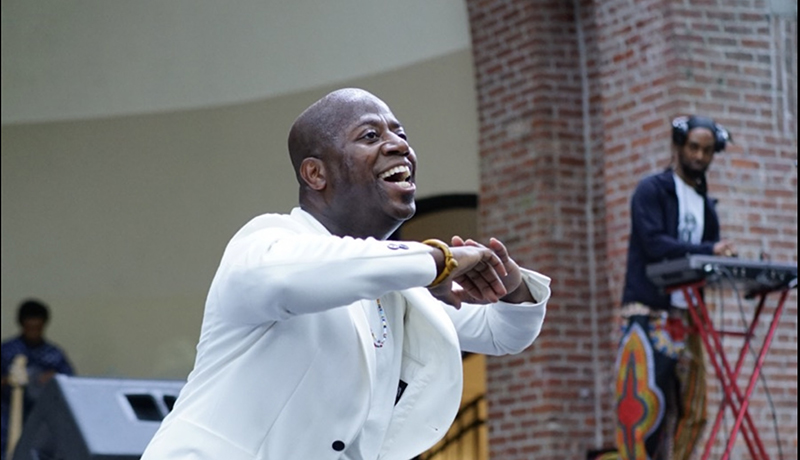
Sekou McMiller at the National Jazz Museum in Harlem’s inaugural Juneteenth Black Music Month celebration at Jackie Robinson Park, 2022. Photo by Nir Arieli.
McMiller’s choreography in Shine exemplifies his effort to push partnered Latin social dances forward by looking to their roots in West African dance, African American jazz, and Caribbean and American dance cultures.
That exploration began in 2016 when he traveled to Cuba to study Afro-Cuban folkloric and modern dances. He returned in 2017, and in 2018 was invited to study at the École des Sables (School of the Sands) in Senegal, the renowned school founded by Germaine Acogny, considered the mother of contemporary African dance. That residency sparked new choreography and a desire to reimagine “storytelling in dance theater with a contemporary African dance language,” McMiller wrote in a crowdfunding post in 2019.
Shine revives the improvised solos that are woven into the tapestry of African and African diasporic dance and music, McMiller observed. They stretch from Sabar dance and drumming in West Africa to styles such as tap, mambo, and hip-hop, he said.
Some of the Shine choreography returns in April with a performance at the LaGuardia Performing Arts Center in Queens, New York, that is part of McMiller’s second CUNY Dance Initiative residency.
Shine is also a prelude to a new project: a musical about the Palladium Ballroom, the Manhattan nightclub considered the home of mambo, which, from 1947 to 1966, was the city’s hottest dance scene. As New York’s first integrated nightclub, the Palladium attracted a who’s who of musicians, dancers, and actors. Marlon Brando, Bob Hope, and Dizzy Gillespie were regulars. The preeminent Latin jazz bands played there: Machito and his Afro-Cubans, Tito Puente, and Tito Rodríguez.
“Shines were a huge, huge part of that era,” McMiller said. “Partnered dancing was amazing but it was less intricate than the shines.”
In July, he’ll return to Jacob’s Pillow to develop his Palladium musical as a choreographer and director in the musical theater program, and he’ll bring his company to perform at the Jacob’s Pillow Dance Festival this summer.
At the Shine performance at the Guggenheim, McMiller expanded on a mambo duet he and dancer Desiree Godsell performed in Harlem in June 2022 and at Jazz at Lincoln Center in June 2023. In the Guggenheim version of the dance, A Stroll in Harlem, they left transitions between choreographed steps open to individual interpretation and created room for brief solo dance breaks. Adding to the improvised feel of the jazz dance, other partnered dancers joined them on the stage, turning the duet into a group dance. And tap dancer Calvin Booker brought a rhythmic percussion to the dancers’ moves.
“Sekou gave us a lot of bandwidth to interpret, to bring ourselves to the dance,” Godsell said about workshopping Shine at Jacob’s Pillow. “And he said this several times, ‘Live your best life.’ So, if you are living your best life, there’s a sense of autonomy that you have over your body.”
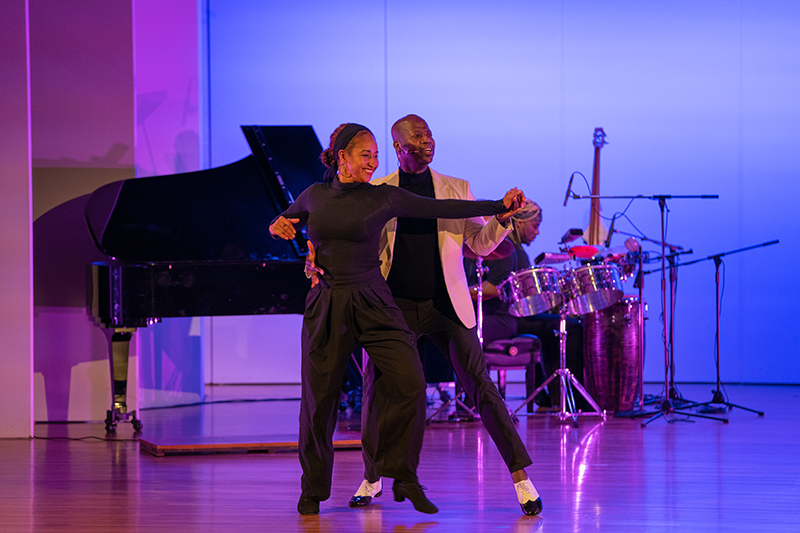
Sekou McMiller and Desiree Godsell perform in Shine at Works & Process at the Guggenheim on November 5, 2023. Presented in partnership with Jacob’s Pillow. Photo: Works & Process / Erick Munari
That spontaneity, which is essential in social Afro Latin dance, is what McMiller wants to bring to his performances. “It’s the lack of individualism, the lack of allowing the individual to explore and become creative in their own space” that’s missing when dances such as salsa and mambo move to the proscenium stage, he said. “Shine is an exploration and a mandate to bring that to the stage.”.
~~
Sekou McMiller presents Afro Latin Soul, an evening-length performance by Sekou McMiller and Friends, at LaGuardia Performing Arts Center in Queens, New York City, on April 26.
Bonnie Eissner is the director of communications at the City University of New York (CUNY) Graduate Center and a writer who covers culture, history, politics, science, and more. You can see samples of her work at linktr.ee/bonnie_writing.
